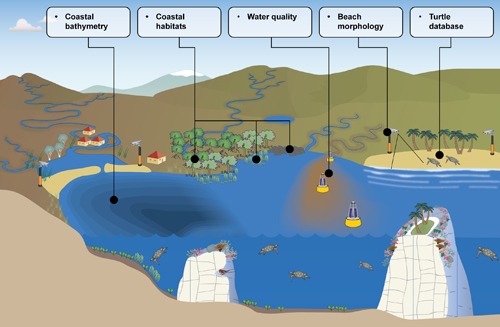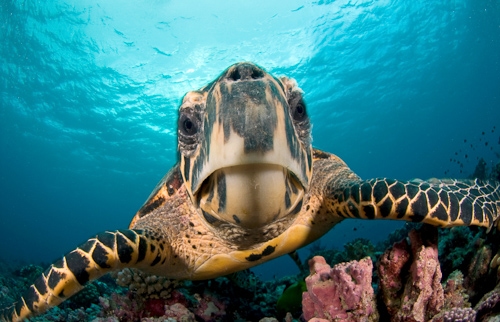The hawksbill turtle (Eretmochelys imbricata) is one of six species of marine turtle that will be studied for the national database. There are only seven species of marine turtle in the world, and six live in Australian waters.
From the Arafura Sea to the Southern Ocean, 85% of Australians live close to the continent’s 36,000 km of coastline — and most of the rest have made a summer pilgrimage to the beach. It’s part of the iconic image of Australia.
Our love of our coasts puts a great deal of pressure on the life that makes up the variety of freshwater and marine ecosystems that are found through 33 degrees of latitude, and influenced by tides from 1 m to 11 m. How do we continue to live well, and simultaneously protect these natural places, both wild and modified by humans?
This is the many-faceted question at the heart of the work of one of TERN’s newest facilities, the Australian Coastal Ecosystems Facility (ACEF), which will provide long-term collection and distribution of datasets on coastal research that can be used in making policy and management decisions about how we protect and use our coasts.
The main datasets ACEF is interested in concern seafloor depth, beach structure, coastal water quality, coastal habitats such as seagrasses and mangroves, and marine turtles.
The Deputy Director of the Coasts facility, Mr Jonathan Hodge, said the ACEF will increase access to data and information about coastal environments, and will build on already well-established communities that span government agencies, professional societies, community groups, universities and research institutions.
‘The ecological, social and physical complexities of Australia’s coastal zone mean that management responses, data collection and information systems – that is, the web-based systems for delivering data, content and other information – are frequently specific to a domain (such as a research area or theme), and to a place and time. Until recently, it was more common that research data wasn’t made accessible to others. These days, however, we need to be smarter about how we use and share this valuable resource. Data is extremely expensive to collect, analyse and synthesise, and now, even if it’s collected for one purpose, it is increasingly being required for other purposes, for example assessing climate risk and modelling environmental scenarios, and for national-scale projects. So the way we deliver the end products of research is changing,’ Jonathan says.
‘From data collection to management actions, a myriad of organisations undertake activities locally, regionally, at state level, and nationally. There has been significant investment in eResearch infrastructure at the national scale through programs such as the National Collaborative Research Infrastructure Strategy (NCRIS). However, many of the tools available haven’t been successfully adopted at the local, regional and state levels; and, coupled with this, activities along a coast are often fragmented. These problems tell us that we need to work on communication, knowledge sharing and the integration of activities across all these scales. One of the things that ACEF can do is to add value to these existing investments to develop integrated biophysical, ecological and environmental-condition datasets that anyone can find and use easily.’
‘This will help “join the dots” across the coastal space, by building knowledge about the national eResearch agenda and making key information discoverable, accessible and usable,’ Jonathan says.
ACEF will also strengthen integration by facilitating coastal communities of practice, which will bring together researchers, managers, industry and the community to identify the most important datasets, improve technologies and identify more funding opportunities.
‘In fact, we have already begun to engage with state and regional organisations to identify and acquire datasets, and we’re encouraged because we are receiving strong interest from across the country. We’re also collaborating across the national space, including with Geosciences Australia, Integrated Marine Observing System (IMOS) and Australian Ocean Data Network (AODN), to help minimise duplication and leverage existing investment,’ Jonathan says.
He said it was important that the custodians of data were able to deliver their information in a way which maintains their ownership and control of it while allowing better use and acknowledgement of data.
‘We will encourage the use of open standards, common licensing frameworks and modern web technologies. In essence, information will exist in a distributed model, that is maintaining connections to data custodians while allowing data to be displayed and accessed by a range of researchers, coastal managers, and ultimately policy and decision-makers,’ Jonathan says.
ACEF’s activities
While orchestration of the data management is occurring in the background, much more visible to the public are the projects and collaborations ACEF is working on. The Coastal Research web portal is the first product launched. Although aimed primarily at local councils and researchers, anyone can use it to find out about current and previous environmental research projects, find publications related to the research, link into the data and metadata, and help build the database by contributing information about their own coastal projects.
‘This will help to close the loop between research and management,’ Jonathan says.
In February, work on the National Marine Turtle Database began. The project will result in a federated database which will simplify access to data and simplify reporting to different state and Commonwealth agencies to meet national and international agreements. ACEF has also engaged CoastalCOMS to deliver automated information about shorelines and wave height using video cameras. You will be able to access raw and summarised data for 17 locations through an online portal. Because the visualisation and integration of disparate datasets is a key to making them user-friendly, ACEF is evaluating ways of simplifying how users can find, visualise and access data in a consistent way.
‘Although many of these datasets are already available directly from the custodians, finding out who to talk to and how to get the information you want can take time. We need to change that to help make use of the valuable data that is out there,’ Jonathan says.
All these projects point to the importance of ACEF having information infrastructure (e.g. servers, data storage) with enough oomph to be able to deliver such rich geo-spatial information. ACEF is developing this capacity using open-source platforms. Currently the infrastructure is hosted by the Queensland Cyber Infrastructure Foundation (QCIF) and CSIRO.
The facility is new, and its website is still being developed, but ultimately people will be able to access coastal data through ACEF and through other national systems such as the TERN central portal and the AODN. If you would like to know more or would like to contribute your data to the Australian Coastal Ecosystems Facility, contact Jonathan by email or visit the TERN website.

ACEF will focus on making key coastal datasets, including water quality, coastal habitats and marine turtles, easy to find and use
Published in TERN e-Newsletter May 2012







